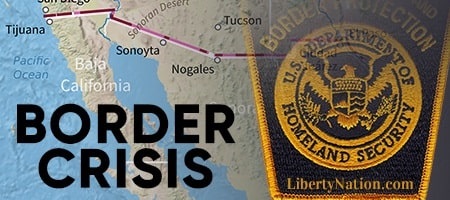Beleaguered Border Patrol doesn’t have enough fingers to count the gotaways.
It’s hard to miss the glaring contradiction in the US government’s approach to immigration. On the one hand, Joe Biden’s administration has opened the southern border to anyone with a pulse. Meanwhile, many American citizens and others find themselves on a Homeland Security terrorist watchlist. The inconsistency with which the Department of Homeland Security treats non-terrorists, potential terrorists, and actual terrorists is staggering.
 The nexus between Biden’s US border security policy and national security portends disaster. Nothing new there. But attempting to keep would-be terrorists from crossing America’s international borders does not appear to be part of the Department of Homeland Security’s (DHS) remit. According to a new study published by the US Senate Committee on Homeland Security and Government Affairs, the DHS process is a mess.
The nexus between Biden’s US border security policy and national security portends disaster. Nothing new there. But attempting to keep would-be terrorists from crossing America’s international borders does not appear to be part of the Department of Homeland Security’s (DHS) remit. According to a new study published by the US Senate Committee on Homeland Security and Government Affairs, the DHS process is a mess.
Terrorist Watchlist Redundant and Inaccurate
Based on the new study’s findings, “As of November 2022, there are approximately 1.8 million records in the terrorist watchlist, up from 150,000 in 2004.” One take on this revised number could be that the Biden administration is taking the watchlist seriously and wants to identify terrorists accurately. That would be wrong, it turns out. A key finding in the study:
“The Terrorist Screening Center manages the Threat Screening System which maintains records in multiple datasets including terrorist screening, military detainee, transnational-organized crime, and additional datasets. Additionally, the terrorist watchlist includes individuals who are relatives or associates of known or suspected terrorists, and individuals it suspects of being terrorists but does not have enough supporting evidence to list as terrorists.”
This might suggest that the management of the watchlist is neither disciplined nor structured enough to be meaningful, with too many poorly integrated and coordinated moving parts. There are 22 reasons why a traveler attempting to board a commercial airline might be held for more thorough screening besides being suspected of terrorism. Additionally, numerous federal agencies have access to and use the various databases associated with the watchlist. The study found that “[w]hile redundancy is a valuable security tool, given the similarity between some of these reasons, there is a likelihood of unnecessary duplication, and repeated and unwarranted screening can have profound impacts on Americans. It can also spread limited national security resources out broadly rather than effectively target changing threats.”
The study indicated that, since 2019, fewer than 0.5% (9,000) of those on the terrorist watchlist were “US citizens and lawful permanent residents.” So, the other 1,791,000 were non-US citizens determined by one or more of the 22 reasons to be of concern. The underlying intent of the study was to identify areas where current procedures are overly broad and “wrongful screening by our government risks eroding Americans’ civil rights and civil liberties.” A press release sent out by the Senate committee admitted: “[T]he federal government has created a layered and duplicative screening system that is so opaque and complicated, it is difficult for the government to explain.”
Watchlist Could Enable Terrorists Slipping Through
The study presented a case for the 0.5% of the citizens or permanent residents who wind up on the terrorist watchlist not being inconvenienced. Besides taking a “convenience of the few is more important than the security of the many” approach, there is a flip side to the flawed terrorist watchlist process: The acknowledged problems could as well easily let real terrorists slip through. And the list, however sweeping it might be, probably does not include the 1.7 million illegal alien “gotaways” who eluded Customs and Border Protection at our southern border and are now roaming the United States. When the House Committee on Homeland Security released its Fiscal Year 2023 border statistics on illegal aliens crossing the southern and northern borders, the data on individuals on the watchlist coming up from the south is sobering. The committee factsheet showed:
“In FY2023, 169 individuals whose names appear on the terrorist watchlist were stopped trying to cross the U.S.-Mexico border between ports of entry. 18 were apprehended in September alone. FY2023 represents a 72% increase from FY2022 for apprehensions of individuals on the terrorist watchlist and is the most on record.”
The focus on the one-half of 1% of the US population who are on the watchlist in error is misplaced. Instead, the emphasis should be on preventing terrorists from getting into the country in the first place. Attempting to tighten up the terrorist watchlist to ensure its accuracy is a worthy effort, but with Biden’s border policy, it’s sure to grow along with the resulting national security risk. The terrorist watchlist — however flawed — is a barometer of the dangers posed by a wide open border.
The views expressed are those of the author and not of any other affiliation.

